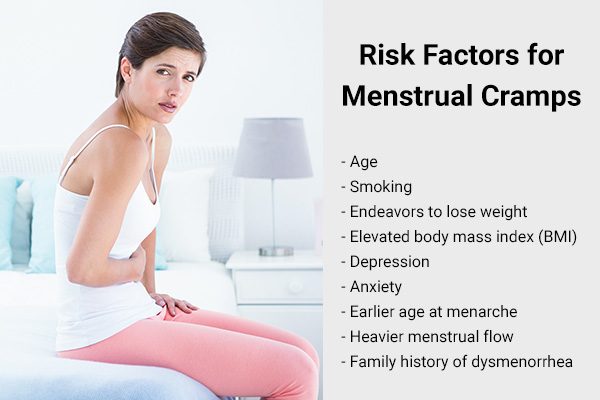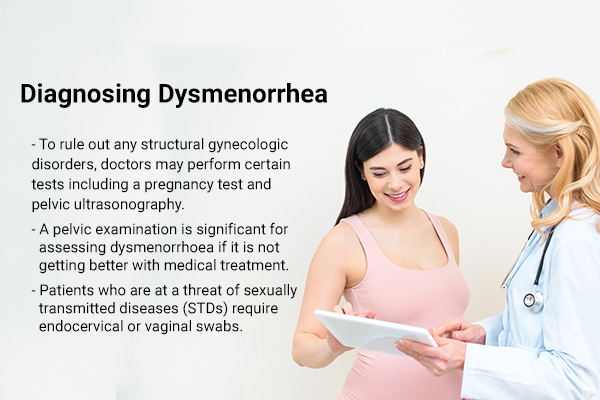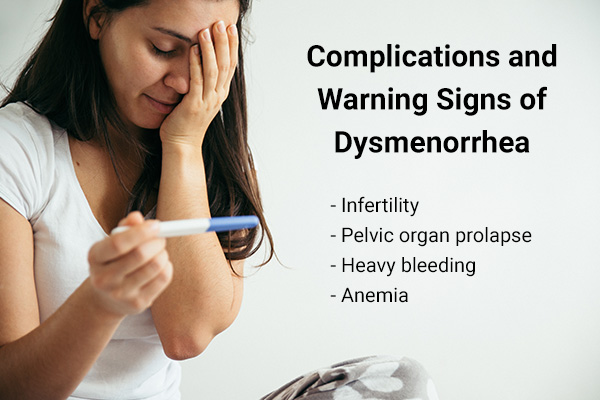In this article:
Many women suffer from difficulties such as cramps and pain during their menstrual cycle. This discomfort is medically called dysmenorrhea, which is a Greek word for “painful monthly bleeding.”

Dysmenorrhea is pain in the lower abdominal area during the menstrual period, which may or may not be linked with other diseases or pathology. It is a familiar complaint among many women during their reproductive age and is linked with considerable emotional, psychological, and functional health consequences.
While experiencing menstruation is a common occurrence in a woman’s life, severe menstrual cramps may not be a usual occurrence. Take a look into it more such as what causes it, how it is diagnosed, and what are its types. (1)(2)
What Causes Period Cramps?
Every month, the lining of a woman’s womb thickens, and it is then shed later on, which is considered the end of the menstrual cycle.
To rid the lining during the menstrual period, the muscles of the uterus contract and relax at an uneven tempo. This enables the tissue of the womb to separate and pour out of the body with blood via the channel formed by the cervix and the vagina.
The muscle contractions are often not evident or only result in a little distress, but they may be occasionally felt as painful cramps. (1)
The common causes of dysmenorrhea include endometriosis, uterine adenomyosis, and fibroids. (2)
Less frequent causes may include:
- Congenital malformations (birth defects)
- Ovarian cysts and tumors
- Pelvic inflammatory disease
- Pelvic congestion
- Copper intrauterine devices (IUDs)
In some cases, the pain occurs due to the uterus attempting to expel tissue through a tightly situated cervical polyp. Secondary dysmenorrhea usually begins in adulthood, unless it’s caused by congenital malformations.
Risk Factors for Menstrual Cramps

Risk factors associated with dysmenorrhea are: (2)
- Age
- Smoking
- Endeavors to lose weight
- Elevated body mass index (BMI)
- Depression
- Anxiety
- Earlier age at menarche
- Heavier menstrual flow
- Family history of dysmenorrhea
Signs and Symptoms of Dysmenorrhea
Dysmenorrhea/pain may start just before or during the menstrual period, and it typically reaches its peak after the onset of menses, lasting for 2-3 days. The pain can vary in intensity and type, ranging from sharp and cramping to throbbing or dull.
Other symptoms include: (4)
- Backache
- Thigh pain
- Headaches
- Diarrhea
- Nausea
- Vomiting
Note: Some women may experience premenstrual syndrome symptoms during their menstrual cycle, and it’s not uncommon to pass endometrial clots or casts during this time.
Treatment for Dysmenorrhea
To improve dysmenorrhea, gynecologists treat underlying disorders and suggest lifestyle changes such as rest, sleep, and exercise.
They may also recommend a low-fat diet and nutritional supplements such as ω-3 fatty acids, flaxseeds, magnesium, vitamin E, zinc, and vitamin B1 for relief from menstrual symptoms.
For pharmacological treatment:
- The first line of treatment for dysmenorrhea is nonsteroidal anti-inflammatory drugs (NSAIDs), which are very effective in inhibiting the production of prostaglandins. Typically, NSAIDs are taken 1–2 days before menstruation starts and continued for a few days. Note: Fenamates such as mefenamic acid may be slightly more effective than other NSAIDs. Paracetamol can be an alternative to NSAIDs where they are contraindicated. (2)
- If NSAIDs don’t work, a low-dose estrogen/progestin oral contraceptive is recommended to suppress ovulation. Oral contraceptive pills (OCPs) have been shown to reduce dysmenorrheic pain among adolescents by limiting endometrial lining growth and decreasing prostaglandin production.
- Progestin-only pills (POPs) are suitable for patients with secondary dysmenorrhea related to endometriosis but may not be effective for primary dysmenorrhea. (2)
- Hormonal treatments, such as danazol, progestins (such as levonorgestrel, etonogestrel, and depot medroxyprogesterone acetate), gonadotropin-releasing hormone agonists, or a progesterone IUD, may decrease dysmenorrhea symptoms.
Diagnosing Dysmenorrhea

Primary dysmenorrhea is diagnosed through examinations: (2)(3)
- To rule out any structural gynecologic disorders, doctors may perform certain tests including a pregnancy test and pelvic ultrasonography.
- A pelvic examination is significant for assessing dysmenorrhea if it is not getting better with medical treatment.
- Ultrasound can be helpful in distinguishing between primary and secondary dysmenorrhea that is caused by endometriosis and adenomyosis.
- Patients who are at risk of sexually transmitted diseases (STDs) require endocervical or vaginal swabs.
- If suggested by specialists, malignancy cervical cytology samples may be needed.
- Magnetic resonance imaging (MRI) may be needed if deep pelvic endometriosis is suspected.
- Laparoscopy may be suggested when all the noninvasive investigations have proven to be ineffective.
Primary Versus Secondary Dysmenorrhea
Primary dysmenorrhea occurs when the period pain is caused by the womb muscle contractions only. Hormone-like substances called prostaglandins play a significant part in this condition.
Primary dysmenorrhea is more expected in women under the age of 30 or women with heavy periods. It can go on in families, and stress plays a function too.
Period pain that is induced by something other than muscle contractions is called secondary dysmenorrhea. This can stem from benign growths in the womb, such as fibroids or polyps, or endometriosis. Sometimes contraceptive IUDs that are employed for birth control can also provoke secondary dysmenorrhea. (1)(2)
Complications and Warning Signs of Dysmenorrhea

Primary dysmenorrhea complications can be: (2)
- Infertility
- Pelvic organ prolapse
- Heavy bleeding
- Anemia
Note: It is crucial to pay attention to any new or sudden pain, constant pain that does not improve, fever, and unusual vaginal discharge. These warning signs require immediate medical attention.
When to See a Doctor
If you have painful periods, you and your doctor should chat about your symptoms and examine your menstrual cycle. If needed, a pelvic exam can be helpful.
If medications do not alleviate your pain, therapy should concentrate on discovering the reason for your pain and fixing it.
Final Word

Menstrual ailments are positively dominant among women and most normally include period pain and mood disturbances. Primary dysmenorrhea affects the majority of women during their reproductive life and is particularly typical in young women.
 Continue Reading7 Home Remedies to Relieve Menstrual Cramps
Continue Reading7 Home Remedies to Relieve Menstrual Cramps
- Was this article helpful?
- YES, THANKS!NOT REALLY


